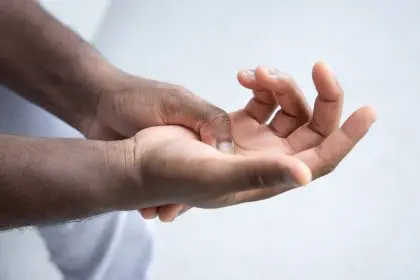When you give a thumbs-up and notice your digit bends backward at an unusually dramatic angle, you’re witnessing what medical professionals call “distal hyperextensibility” — though most people know it simply as hitchhiker’s thumb.
This distinctive trait occurs when the tip of your thumb extends more than 50 degrees toward your wrist, creating that eye-catching backward bend. While it might seem like nothing more than an anatomical curiosity, this flexibility could potentially signal something more significant about your body’s overall joint mobility.
The condition stems from hyper-flexible ligaments in the thumb joint that allow for this extended range of motion. For most people, it’s completely harmless and simply an interesting quirk of their physical makeup.
3 fascinating facts about hitchhiker’s thumb
- It’s remarkably common If you have hitchhiker’s thumb, you’re in good company. Research suggests this trait is far from rare — a 2012 study found approximately 32.3% of people examined displayed the characteristic. Even more intriguing, earlier research from 1953 conducted at Johns Hopkins University revealed potential demographic differences, with the trait appearing in 24.7% of white participants and 35.6% of Black participants in the U.S. This suggests genetic factors may influence who develops this distinctive thumb flexibility.
- Your bendy thumb might signal broader joint flexibility For some individuals, a hitchhiker’s thumb is just the beginning of a broader story about joint mobility. The trait can sometimes indicate a general tendency toward hypermobility throughout the body. This doesn’t necessarily mean there’s cause for concern, but in some cases, it may connect to conditions like hypermobility Ehlers-Danlos Syndrome (hEDS) or hypermobility spectrum disorder. These conditions involve loose ligaments that allow joints to move beyond their normal range of motion. While most people with hitchhiker’s thumb won’t have these disorders, it’s worth noting that hypermobility can sometimes contribute to joint instability, discomfort, or other symptoms as you age.
- Genetics plays a major role That distinctive bend likely runs in your family. Genetics appears to be a significant factor in determining whether someone develops hitchhiker’s thumb. Like many physical traits, it follows inheritance patterns, though the exact genetic mechanisms aren’t fully understood. While some people with the trait might have hyper-flexible joints throughout their body, others may experience this flexibility only in their thumbs. The variation highlights how complex genetic expressions can be, affecting different body parts to different degrees even within the same individual.
What hitchhiker’s thumb might mean for your health
For most people, having bendier-than-average thumbs causes no medical concerns whatsoever. However, in certain contexts, this trait could potentially connect to other conditions that warrant attention.
If hitchhiker’s thumb appears alongside symptoms like joint pain, frequent dislocations, or unusually stretchy skin, it might be part of a broader hypermobility condition. Hypermobility disorders can sometimes be associated with chronic pain, fatigue, anxiety, depression, and other symptoms that affect quality of life.
As people with hitchhiker’s thumb age, some may face increased risks of joint-related issues. The extra flexibility can sometimes contribute to earlier onset of arthritis or tendon problems, particularly if the joints are subjected to repetitive strain.
In rare cases, the trait might appear in conjunction with genetic conditions like diastrophic dysplasia, which affects cartilage and bone development. However, such associations are uncommon, and most people with hitchhiker’s thumb never experience related medical issues.
Managing life with extra-bendy thumbs
Since hitchhiker’s thumb typically doesn’t cause problems, most people never need treatment for the condition itself. However, if you experience discomfort or instability, several approaches can help:
Strengthening exercises targeting the muscles around the thumb joint can provide additional support. Simple activities like squeezing a stress ball or using therapy putty can build up these small but important muscles.
For those who experience pain or instability, especially during activities that strain the thumb, braces or taping techniques can offer added support. These approaches are particularly helpful during activities that might otherwise aggravate the joint.
Generally maintaining good joint health through regular, gentle movement and avoiding excessive strain can help prevent potential issues as you age. This includes being mindful of repetitive motions that might place stress on the thumb joint.
When to consult a healthcare professional
While hitchhiker’s thumb itself rarely requires medical attention, certain situations might warrant a conversation with your doctor:
If you notice your thumb flexibility is accompanied by pain, swelling, or reduced function, these symptoms deserve professional evaluation regardless of your natural joint mobility.
Individuals who experience multiple hyper-mobile joints, frequent dislocations, unexplained pain, or unusual skin elasticity might benefit from evaluation for broader hypermobility conditions.
Those with a family history of connective tissue disorders who also display hitchhiker’s thumb might consider genetic counseling or evaluation, particularly if planning a family.
The future of understanding joint hypermobility
Research into conditions like hitchhiker’s thumb and broader hypermobility disorders continues to evolve. Scientists are working to better understand the genetic factors that influence joint flexibility and how these traits might connect to overall health outcomes.
Newer diagnostic approaches are helping identify hypermobility conditions earlier, potentially leading to better management strategies for those affected. For most people with hitchhiker’s thumb, however, the trait remains simply an interesting example of human diversity.
As with many aspects of human physiology, what seems like a simple trait can reveal fascinating connections to our genetic makeup, evolutionary history, and potential health considerations. Your bendable thumb tells a unique story about your body’s structure and function — one that’s shared by roughly a third of the population.
Embracing your unique traits
Hitchhiker’s thumb exemplifies how human bodies can vary in remarkable ways while still functioning perfectly well. For most who have this trait, it’s nothing more than an interesting anatomical variation — much like attached versus detached earlobes or the ability to roll your tongue.
The diversity of human physical traits reminds us that “normal” encompasses a wide range of variations. Whether your thumbs bend dramatically backward or remain relatively straight, they’re part of what makes your body uniquely yours.
If you do have hitchhiker’s thumb, you might find it’s an excellent conversation starter or a surprising party trick. Just remember that while this flexibility might occasionally draw attention or curiosity, for the vast majority of people, it’s simply one more fascinating example of human diversity in action.














